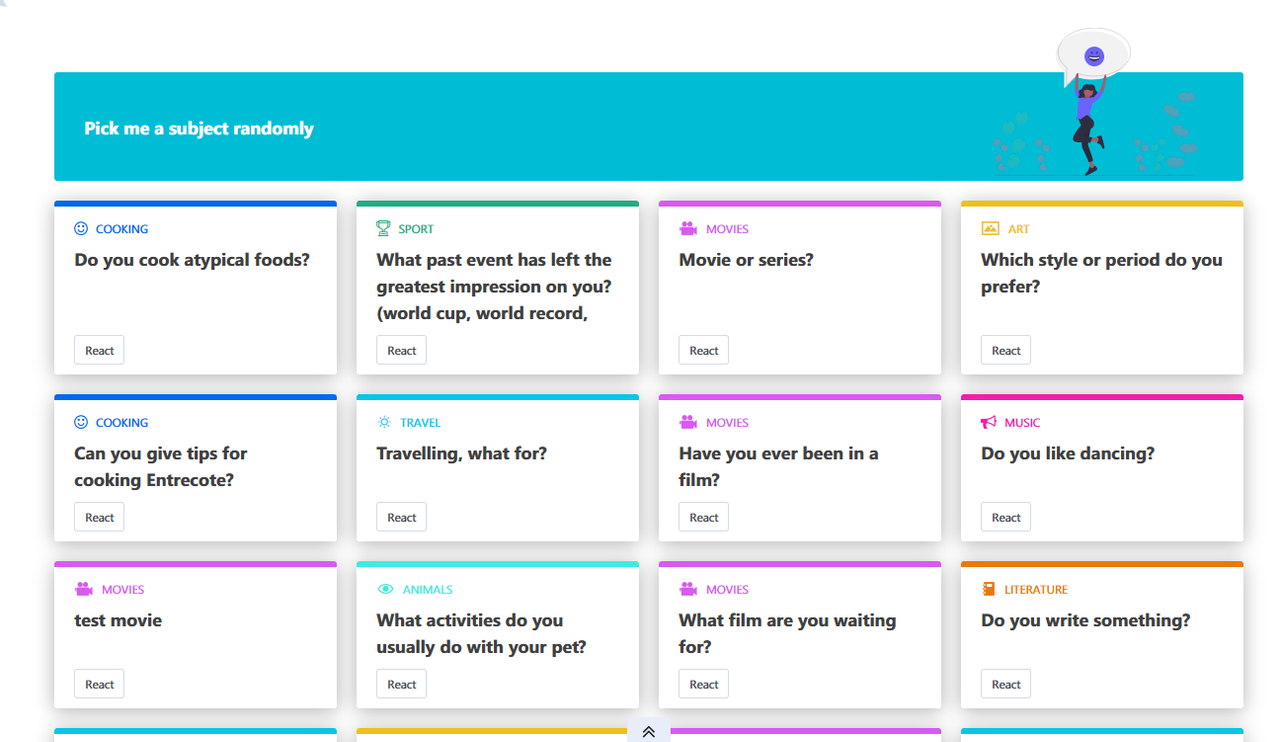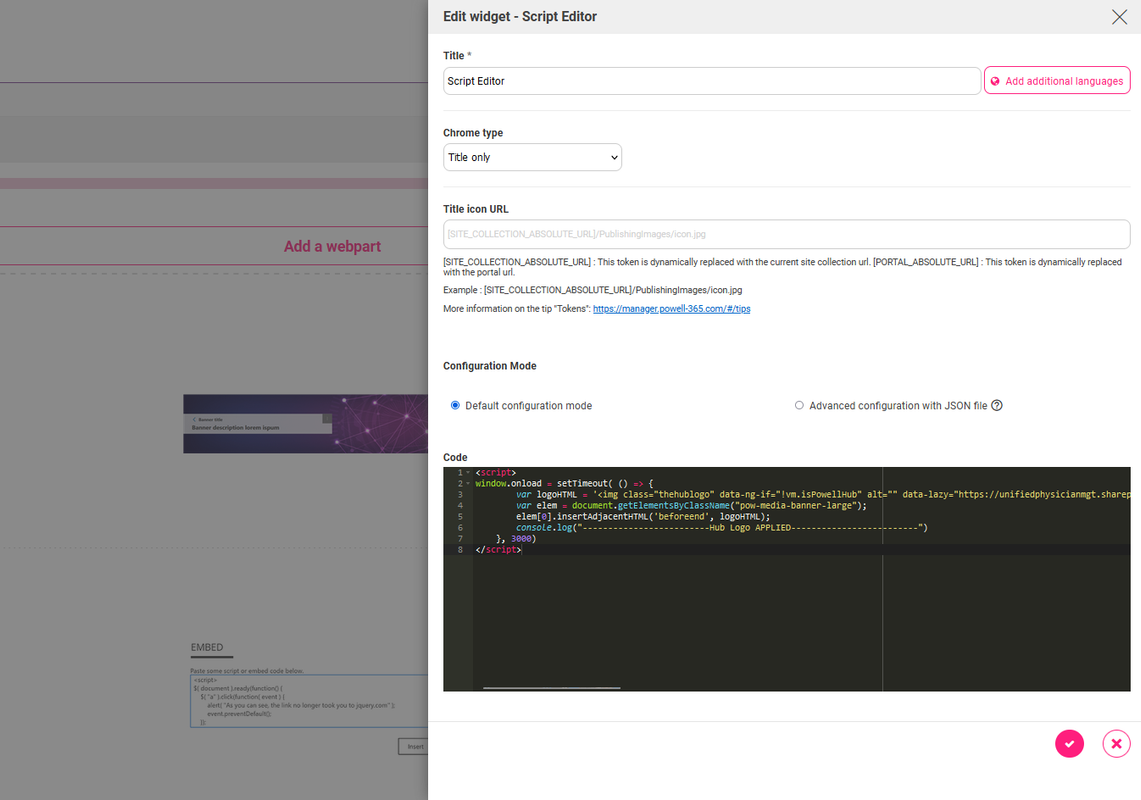Table of Contents
Species
Banner
It is what it says it is. Unfortunately, there are two Title inputs and a Description which gets confusing. The first Title is used internally for the webpart. The second Title is the top part of the banner with the arrow. The text below it is the description. If the text for description is not included, it defaults to the format [Page Name] - [Title]. If the text for the title is not included, the top text defaults to the page name.
Combined Search
This webpart can display multiple query results through the use of tabs.
Example
Example Recipe: Combined Search Videos

Discussion Tiles
This webpart can only be used by pre-programmed Powell Intranet site templates like the Water Fountain Page. In other words, this webpart is useless to Powell users.

Divider
This webpart is basically the equivalent of <hr> html tag.
Example recipe
Script Editor
This webpart allows users to insert a script tag from Powell Manager.

Search webpart
Powell support once told me in a call that "about 80% of the webparts that we use are Search webparts". That being said, a picture of a Search webpart is not enough to show what it is or what it can do. It's fairly moldable to the user's desires as it can be used with most Display widgets.
Text
The very last option that looks like < > shows what is going be on the page in raw HTML. Unfortunately, you'll need to save, sync, and then look at the SharePoint site to look at your pages. There is a bug where deleting empty spacer tags like below while in code view and then save, the empty tags will still remain there. Delete newline spacer tags from the text view instead and then save. It appears that changes are only saved if you press the save button while in text view. Pressing save while in code view.
<p>
<br>
</p>
Example recipe
Text Caveats
Because we can just create HTML from the text view, it might seem all-powerful, however, all it takes is one user to Edit and Republish the page on SharePoint to remove all of your tags and info that is not <p> or <br> tags.
Title
This is like the title part of many web parts. In Edit widget, to prevent redundant titles, we recommend setting the top Title to Hidden in the Chrome type dropdown.
Example recipe
Edit Widget Explanations
Search Query
In Powell, you may have seen this Search query box, called either Search query or Search query template:

The language used in this particular search box is Keyword Query Language (KQL). KQL is used to build search queries for the SharePoint search service. For syntax and more, please refer to documentation here. These search queries allow developers to query the SharePoint site, often times for looking for info in site contents.
Keep in mind that there is an entirely separate query language with the same acronym that Microsoft uses for Azure called Kusto Query Language (KQL). This is not used in SharePoint.
KQL Cheat Sheet
Examples
Query for mp4 videos in the entire site contents:
Search query template
FileType: mp4
KQL filter = FileType: mp4
Query for mp4 Videos in the Communications Document Library:
Search query template
PATH: "https://unifiedphysicianmgt.sharepoint.com/sites/UnifiedWomensHealth/Communications/Forms" FileType: mp4
- SharePoint base URL =
https://unifiedphysicianmgt.sharepoint.com/sites/UnifiedWomensHealth - SharePoint Document Library =
/Communications - SharePoint Document Library View =
/Forms - Additional KQL filter =
FileType: mp4
Debugging Queries
The most efficient method of debugging KQL queries in Powell SharePoint is to use the Test button on the Query Builder.
- On your SharePoint Site with Powell, click on Edit in the top right corner.
- Edit the webpart that you wish to debug. If it's combined search webpart, you might need to click on an internal edit button as well.
- Under Content Search edit mode, expand Query Builder
- The Test button is at the bottom just before the Display header.
When you're done testing, always Discard changes in the upper left corner. Otherwise, there is a timer that will take you out of edit mode involuntarily.
Avoid Nesting Folders in SharePoint Sites
Folders as seen on the site contents level in the SharePoint site are special folders called Document Library folders. If we want to limit grabbing items from a specific folder can only limit the scope of information grabbed by Document Library folders. The same information will be grabbed at the Document Library level folder will be grabbed from the nested folder. Nested folders do not help with organization. Only keep files and lists folders for content in Powell. Do not use folders within folders.
Form View
You may be tempted to use:
PATH: "https://unifiedphysicianmgt.sharepoint.com/sites/UnifiedWomensHealth/Communications"
but we actually need to use
PATH: "https://unifiedphysicianmgt.sharepoint.com/sites/UnifiedWomensHealth/Communications/Forms"
because we need the Forms view of the files.
Row limit
Think of a SharePoint list. Each row in this case is an item on the list. Therefore, row limit really means item limit.
Example
In the grid list of links recipe, we want an arbitrary max of 27 rows or 27 items that will be grabbed from the SharePoint List
Display or Select Widgets
When building a webpart, there is often a secondary choice of the Display widget. Not all webparts have display widgets. For example, the discussion tiles webpart cannot display a specific widget other than what it comes with.
Species
Application Tiles 2
TODO
Tips and Tricks
Determine the Type of Webpart By Inspecting SharePoint Site with Dev Tools
The type of webpart can be found in the data-sp-feature-tag. You'll want to inspect the page, and press Ctrl + F to find this attribute in the HTML. It may look like the following:
<div data-sp-feature-tag="PowellScriptEditorWebPart web part (Search)" ...>...</div>
The webpart featured here is Search.